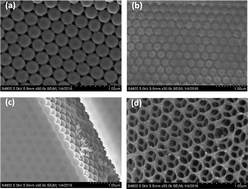Flexible construction of cellulose photonic crystal optical sensing nano-materials detecting organic solvents
Abstract
We developed a simple and efficient method to construct 3D and 2D opal and inverse opal cellulose photonic crystal films (CPCF) by embedding 3D or 2D polymethyl methacrylate (PMMA) colloidal arrays into carboxymethyl cellulose (CMC), respectively. The morphology and optical performance of CPCFs were characterized by SEM, diffraction spectra, Debye rings, and structural color. The brilliant structural colors of CPCFs are visible to the eye in the entire visible spectrum, and can be tuned by changing the particle diameters or the pore sizes. Attributed to decreased particle spacing and lower average refractive index caused by air spheres instead of polymer spheres, the stopbands of the inverse opal CPCFs blue-shifted. To the contrary, the particle spacing of 2D inverse opal CPCFs increased due to the losing of the connection force of 2D arrays, along with decreasing of Debye ring diameters. By alternately being exposed to organic solvents of methanol, acetonitrile, butanol, dioxane, and carbon tetrachloride, the 3D inverse opal CPCFs displayed an excellent sensing performance with instantaneously reversible color changes from violet to red. Their high stability and flexibility, efficient visual detection, and wide range of analytes promises a new opportunity for optical switching and sensing applications.



 Please wait while we load your content...
Please wait while we load your content...